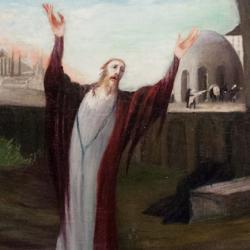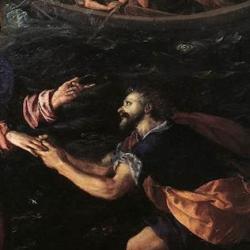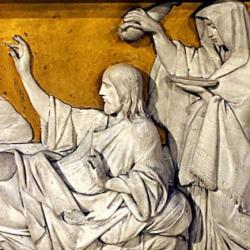INTRODUCTION
Jesus arrives in Jerusalem like a king (21:5) and immediately goes to the temple. It is His first visit to the temple in Matthew’s gospel, and He is not impressed. He condemns it as a robbers’ den, and then sets up His own ministry of healing in the house of prayer.
THE TEXT
“Now when they drew near Jerusalem , and came to Bethphage, at the Mount of Olives , then Jesus sent two disciples, saying to them, ‘Go into the village opposite you, and immediately you will find a donkey tied, and a colt with her. Loose them and bring them to Me . . . .’” (Matthew 21:1-17).
ROYAL ENTRY
Donkeys are not highly regarded today, but donkeys and mules were a royal animals in ancient Israel (cf. Judges 10:4; 12:14; 1 Samuel 9:1-5; 2 Samuel 18:9; 1 Kings 1:32-40). Horses were associated with war, but a king on a donkey was a king of peace. The crowds know this, and hail Jesus as the King coming to Zion . Their acclamation (v. 5) combines Isaiah 62:11, which promises that salvation will come to Daughter Zion, and Zechariah 9:9, which portrays the arrival of a conquering king. They also celebrate His coming by hailing Him as “son of David” (v. 9) and by singing Psalm 118, the same Psalm Jesus later quotes to the Pharisees (Matthew 21:42 ). Like Jehu, Jesus rides on a carpet of garments (2 Kings 9:13 ), and like Jehu He heads to a temple that will be destroyed (2 Kings 10:18 -28). When the magi visited Jerusalem , the city was stirred (Matthew 2:3), and it happens again when Jesus enters ( 21:10 ). The presence of the prophet Jesus, the son of David, throws the capital into turmoil. No wonder the scribes, Pharisees, and priests are disturbed.
FROM ROBBERS’ DEN TO HOUSE OF HEALING
When He enters the temple, Jesus casts out the buyers and sellers and overturns the tables of the money-changers. He is not condemning cheating by the sellers in the temple; why would he throw out the buyers? Nor is He displeased with the fact that there is a market for sacrificial animals in the temple; that was a natural product of temple worship (cf. Deuteronomy 14:22 -27). The economic transactions of the temple symbolize the spiritual transactions, and interrupting the buying and settling literally interrupts the sacrificial worship. Jesus is pre-enacting a destruction of the temple, warning the people, in the words of Jeremiah, that the Lord would destroy their “robbers’ den” (v. 13; cf. Jeremiah 7:11 ), the place where robbers retreat for safety. Quoting Isaiah, Jesus says that the temple should be a “house of prayer” (v. 13), but He doesn’t set up a prayer meeting. He begins to heal. Compassion for the blind and lame is true prayer, true sacrifice. It’s what the temple is for.
CHILDREN
The chief priests and scribes are indignant at Jesus’ actions (v. 15; cf. 20:24 ), and especially at the praise Jesus receives from children. Jesus, though, teaches that the kingdom of heaven is made up of “children” (cf. 18:1-5; 19:13 -15). Infants and nursing babies are the true priests of Jesus’ temple, the ones who give Him fitting praise ( 21:16 ). In His first visitation of the temple, Jesus condemns the temple leaders and invites them to join the children’s choir of the kingdom. He leaves the city, and leaves them time to repent.











